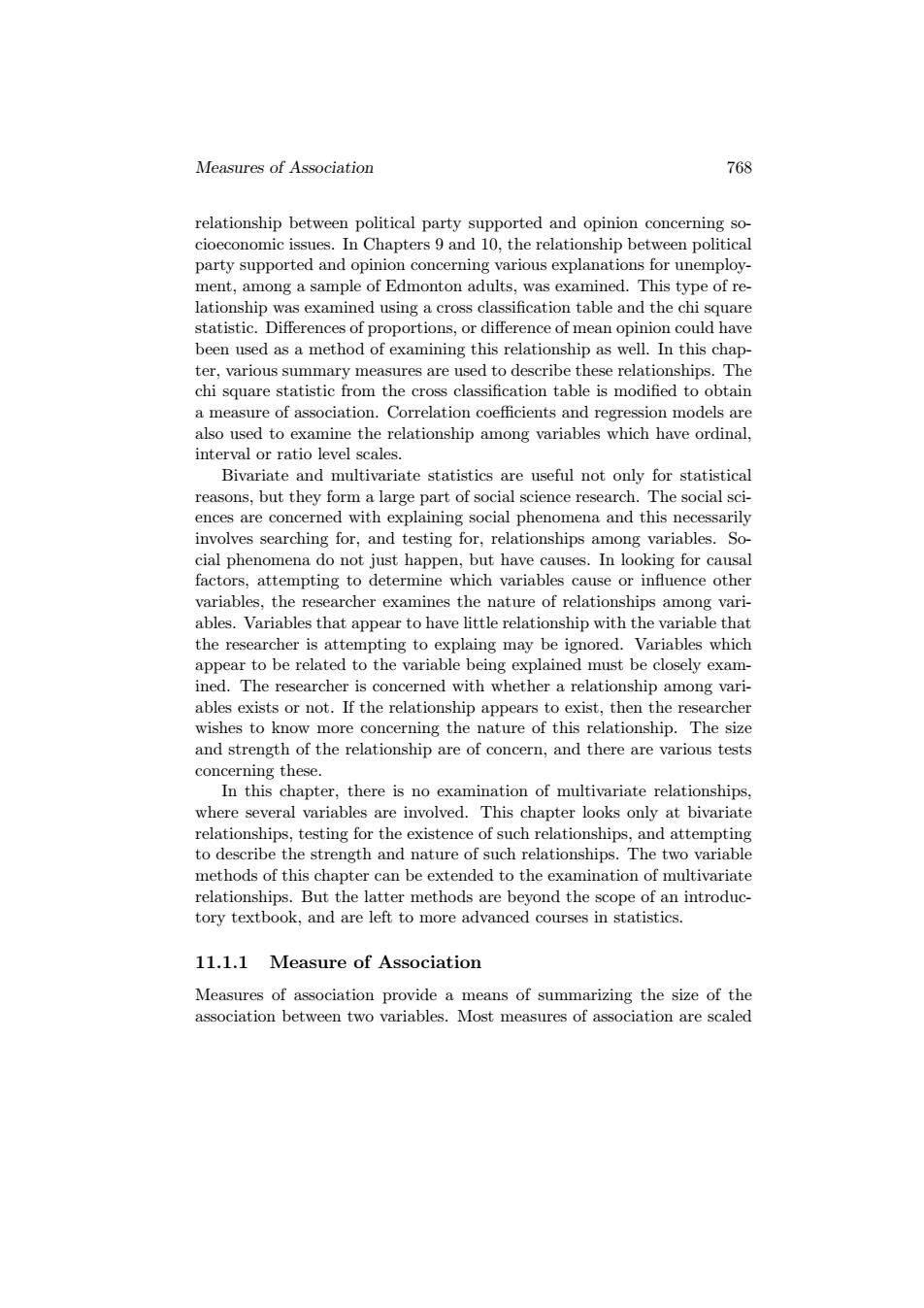正在加载图片...

Measures of Association 768 relationship between political party supported and opinion concerning so- cioeconomic issues.In Chapters 9 and 10.the relationship between political party supported and opinion concerning various explanations for unemploy- ment,among a sample of Edmonton adults,was examined.This type of re- lationship was examined using a cross classification table and the chi square statistic.Differences of proportions,or difference of mean opinion could have been used as a method of examining this relationship as well.In this chap- ter,various summary measures are used to describe these relationships.The chi square statistic from the cross classification table is modified to obtain a measure of association.Correlation coefficients and regression models are also used to examine the relationship among variables which have ordinal, interval or ratio level scales. Bivariate and multivariate statistics are useful not only for statistical reasons,but they form a large part of social science research.The social sci- ences are concerned with explaining social phenomena and this necessarily involves searching for,and testing for,relationships among variables.So- cial phenomena do not just happen,but have causes.In looking for causal factors,attempting to determine which variables cause or influence other variables,the researcher examines the nature of relationships among vari- ables.Variables that appear to have little relationship with the variable that the researcher is attempting to explaing may be ignored.Variables which appear to be related to the variable being explained must be closely exam- ined.The researcher is concerned with whether a relationship among vari- ables exists or not.If the relationship appears to exist,then the researcher wishes to know more concerning the nature of this relationship.The size and strength of the relationship are of concern,and there are various tests concerning these. In this chapter,there is no examination of multivariate relationships, where several variables are involved.This chapter looks only at bivariate relationships,testing for the existence of such relationships,and attempting to describe the strength and nature of such relationships.The two variable methods of this chapter can be extended to the examination of multivariate relationships.But the latter methods are beyond the scope of an introduc- tory textbook,and are left to more advanced courses in statistics. 11.1.1 Measure of Association Measures of association provide a means of summarizing the size of the association between two variables.Most measures of association are scaledMeasures of Association 768 relationship between political party supported and opinion concerning socioeconomic issues. In Chapters 9 and 10, the relationship between political party supported and opinion concerning various explanations for unemployment, among a sample of Edmonton adults, was examined. This type of relationship was examined using a cross classification table and the chi square statistic. Differences of proportions, or difference of mean opinion could have been used as a method of examining this relationship as well. In this chapter, various summary measures are used to describe these relationships. The chi square statistic from the cross classification table is modified to obtain a measure of association. Correlation coefficients and regression models are also used to examine the relationship among variables which have ordinal, interval or ratio level scales. Bivariate and multivariate statistics are useful not only for statistical reasons, but they form a large part of social science research. The social sciences are concerned with explaining social phenomena and this necessarily involves searching for, and testing for, relationships among variables. Social phenomena do not just happen, but have causes. In looking for causal factors, attempting to determine which variables cause or influence other variables, the researcher examines the nature of relationships among variables. Variables that appear to have little relationship with the variable that the researcher is attempting to explaing may be ignored. Variables which appear to be related to the variable being explained must be closely examined. The researcher is concerned with whether a relationship among variables exists or not. If the relationship appears to exist, then the researcher wishes to know more concerning the nature of this relationship. The size and strength of the relationship are of concern, and there are various tests concerning these. In this chapter, there is no examination of multivariate relationships, where several variables are involved. This chapter looks only at bivariate relationships, testing for the existence of such relationships, and attempting to describe the strength and nature of such relationships. The two variable methods of this chapter can be extended to the examination of multivariate relationships. But the latter methods are beyond the scope of an introductory textbook, and are left to more advanced courses in statistics. 11.1.1 Measure of Association Measures of association provide a means of summarizing the size of the association between two variables. Most measures of association are scaled